Are you moving? Renovating your home? Or do you simply want to replace an old mattress? Whatever your reason for a new mattress, we understand choosing the right one can be a pretty tough task.
A comfortable mattress needs to meet an array of requirements—it needs to be the right size, compatible with your body type, and accommodating of your preferred sleeping position. Ultimately, a high-quality mattress should boost your night’s sleep, and as a result, your overall health and well-being.
After all, we spend a third of our lives sleeping—it’s our duty to ensure we have the best mattress to rejuvenate each and every night.
Quick View: The Best Mattresses of 2023
Editors’ Recommendation: Amerisleep AS3
Best Memory Foam Mattress: Zoma Mattress
Best Hybrid Mattress: Amerisleep AS5 Hybrid
Best Mattress On Amazon: Vaya Mattress
Best Mattresses of 2023
To narrow down the thousands of mattress options available, we’ve put together this mattress review discussing top-rated mattress models of 2023. Whether you’re looking for a firm mattress, a mattress for back pain relief, or a cloud-like, all-foam bed, we’ve got you covered.
1. Amerisleep AS3
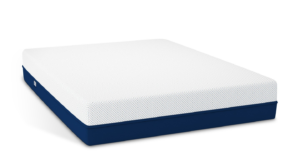 The Amerisleep AS3 is our recommended mattress of 2023. It’s built to accommodate the majority of body types and sleeping positions. Plus, it features plant-based foams and sleep-promoting technologies to facilitate deep, restorative rest.
The Amerisleep AS3 is our recommended mattress of 2023. It’s built to accommodate the majority of body types and sleeping positions. Plus, it features plant-based foams and sleep-promoting technologies to facilitate deep, restorative rest.
The AS3 is one of the most versatile mattresses available on the market this year. It’s designed to adapt to any type of sleeper. This is a huge bonus for individuals who like to change sleeping positions many times during the night.
Now, let’s have a look at the Amerisleep AS3 mattress and its specifications:
The AS3’s soft, breathable cover is designed to keep air flowing throughout the mattress. You never have to worry about overheating with the AS3. The cover is also removable and completely washable so it is easy to keep your mattress clean and in good condition.
The first layer of the AS3 is 3 inches of pressure-relieving Bio-Pur®, a plant-based memory foam. Bio-Pur® doesn’t have the chemical-like “memory foam smell” of many foam beds because it’s plant-based. It’s also more breathable and responsive than traditional memory foam. The thickness of this Bio-Pur® layer is perfect for alleviating pressure points and supporting a healthy spine. However, this bed may feel too soft to adequately support stomach sleeping. Combination sleepers will also benefit from Bio-Pur®, as its responsiveness prevents you from ever feeling “stuck” in the bed.
Below the comfort layer of plant-based memory foam is the AS3’s Affinity layer with HIVE® technology. The Affinity layer buffers between the soft memory foam above and the durable core of the mattress below. This transition layer prevents sinking through the top layer and bottoming out on a solid block of foam. The HIVE® technology within this layer offers dynamic, full-body support.
HIVE® contains hundreds of hexagonal cutouts arranged in distinct zones. These cutouts are closer together to offer firmer support under your head, lower back, and feet. They’re further apart under the shoulders and hips to allow for deeper compression and improved pressure relief. HIVE® maintains healthy spinal alignment, alleviates pressure, and prevents aches and pains.
The base layer of the AS3 is 7 inches of Bio-Core®, a sturdy, long-lasting poly-foam. Bio-Core® reinforces the two layers above it and prevents sagging, extending the bed’s lifespan.
Amerisleep makes and sells five different mattresses, each ranging in firmness. If you order the AS3 and find it isn’t a fit for you, you have the option to return it for a full refund. You can find Amerisleep mattresses in their showrooms, on their website, and on Amazon. Every mattress comes with a 100-night sleep trial with a 30-night break-in period, free shipping, and a 20-year warranty.
2. Zoma Mattress
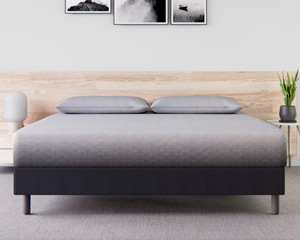 Next on our list is the Zoma mattress, a memory foam mattress designed to help athletes sleep deeper and recover faster. Equipped with Triangulex™ technology, the Zoma is built to enhance your quality of rest so you can be the best version of yourself during the day.
Next on our list is the Zoma mattress, a memory foam mattress designed to help athletes sleep deeper and recover faster. Equipped with Triangulex™ technology, the Zoma is built to enhance your quality of rest so you can be the best version of yourself during the day.
The Zoma Mattress contains three layers and stands 11 inches tall; all in all, it is a medium in terms of firmness. We recommend the Zoma for side, back, and combination sleepers but suggest stomach sleepers choose a firmer bed.
The first layer of the Zoma is 2 inches of gel-infused memory foam. When you lay on this mattress, the memory foam layer contours to your body to offer immediate pressure relief and comfort. The cooling gels within this layer dissipate body heat to prevent night sweats and keep you at a comfortable temperature. Zoma also includes its Triangulex™ technology within this layer to offer zoned support.
Triangulex™ is similar to the HIVE® technology we discussed above. They both have distinct zones of support. Triangulex™ is firm under your torso to prevent sinkage and maintain proper spinal alignment. But it features triangle-shaped cutouts under the shoulders and hips to allow for enhanced pressure relief.
Next, is a 2-inch layer of Reactiv™, a latex-like poly-foam. Reactiv™ is designed to be more responsive than most foams, so it gives the bed a bit of bounce and prevents you from feeling “stuck” in the layers of foam.
The third and final layer of the Zoma mattress is 7 inches of Support+, a sturdy poly-foam. Support+, as its name suggests, offers support for the two layers above, providing edge support, and premature wear and tear.
The Zoma mattress is sold online-only, it comes with a 100-night sleep trial, a 10-year warranty, and free shipping.
3. Amerisleep AS5 Hybrid
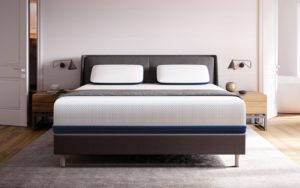 In addition to their advanced memory foam mattresses, Amerisleep also offers three hybrid models. Hybrid mattresses combine a foam comfort layer and an innerspring support base. With the use of their plant-based memory foam, Amerisleep’s AS5 Hybrid is one of the most advanced hybrid mattresses on the market.
In addition to their advanced memory foam mattresses, Amerisleep also offers three hybrid models. Hybrid mattresses combine a foam comfort layer and an innerspring support base. With the use of their plant-based memory foam, Amerisleep’s AS5 Hybrid is one of the most advanced hybrid mattresses on the market.
The AS5 Hybrid is Amerisleep’s softest hybrid mattress, and it’s ideal for side sleepers and lightweight sleepers. When side sleepers rest on a bed that is too firm, painful pressure points can form near the heaviest parts of the body, such as the hips and shoulders. Therefore, side sleepers need more cushioning. Lightweight sleepers tend to sink less, so they also need more softest to experience the beneficial contouring of memory foam.
Like all of Amerisleep’s mattresses, the AS5 Hybrid features a breathable cover that keeps air circulating the surface of the bed. Since the cover is washable, it is easy to clean and maintain.
The Bio-Pur® comfort layer in the AS5 Hybrid has a “cloud-like” surface. This layer cradles the body with a balance of plush comfort and responsiveness. Since soft mattresses are prone to excessive sinking, Amerisleep has also included their Active Flex foam layer. Active Flex is designed to increase the responsiveness of the mattress, so you never feel “stuck” in the bed. Active Flex also ensures that the spine remains in a healthy, neutral position.
Supporting both of these layers is a base of individually wrapped steel coils. These coils are tuned to be softer near pressure points and firmness near the areas that need more support.
This mattress is perfect for those looking for the soft comfort of memory foam to cushion sensitive joints. Plus, the Active Flex layer and coil support base promote a good sleep position so you can sleep soundly and wake up rejuvenated.
Amerisleep’s Hybrids are sold directly on their website or Amazon. Their hybrids come with the same 100-night sleep trial and 20-year warranty as their memory foam mattresses.
4. Vaya Mattress
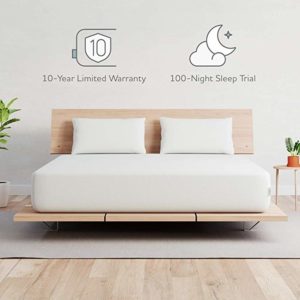 The Vaya Mattress is a budget-friendly foam mattress suitable for all sleepers. Its medium firmness offers enough cushioning for side sleeping. Plus, it provides adequate support for a healthy alignment in the back and stomach sleeping positions. Plus, it costs $595 for a queen size, making it one of the most inexpensive quality mattresses available.
The Vaya Mattress is a budget-friendly foam mattress suitable for all sleepers. Its medium firmness offers enough cushioning for side sleeping. Plus, it provides adequate support for a healthy alignment in the back and stomach sleeping positions. Plus, it costs $595 for a queen size, making it one of the most inexpensive quality mattresses available.
The Vaya Mattress has two layers and contains a woven cover to promote breathability. Altogether, its two layers are 11 inches thick.
The cover of the Vaya is a blend of rayon, spandex, and polyester to enhance airflow through the mattress and prevent heat retention.
Below the cover is a 3-inch comfort layer of Vaya foam, a latex-like poly-foam. Vaya foam contours to the body for comfort but is still bouncy enough to keep you lifted “on top” of the mattress. Vaya foam is less dense than traditional memory foam, so it doesn’t trap heat and instead, keeps you sleeping cool.
The second layer of the Vaya is 9 inches of high-density poly-foam to give the bed shape and firm support. The core layer of the Vaya also helps with distributing your weight evenly and preventing pressure points.
Vaya is an online mattress brand that sells their products on Amazon. Every Vaya mattress comes with a 100-night sleep trial and a 10-year warranty.
5. Tuft & Needle Hybrid
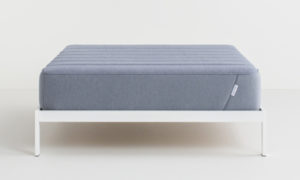 If you’re looking for a bouncier bed, consider Tuft & Needle’s Hybrid. The T&N Hybrid combines all of the original T&N mattress’s sleep-promoting features with bouncy innerspring coils. It has a firm feel in comparison to most of the mattresses we’ve featured thus far. This mattress is described as medium-firm and we recommend it to side, back, and stomach sleepers alike.
If you’re looking for a bouncier bed, consider Tuft & Needle’s Hybrid. The T&N Hybrid combines all of the original T&N mattress’s sleep-promoting features with bouncy innerspring coils. It has a firm feel in comparison to most of the mattresses we’ve featured thus far. This mattress is described as medium-firm and we recommend it to side, back, and stomach sleepers alike.
First, the T&N features a quilted pillow top to offer plush cushioning without feeling too sinking. Tuft & Needle incorporates carbon fibers in this foam layer to improve temperature regulation.
The first layer of the mattress is 2 inches of T&N Adaptive® foam, a poly-foam designed to be more pressure-relieving than traditional memory foam. Instead of using standard memory foam in their mattresses, Tuft & Needle uses their proprietary Adaptive® foam. This layer offers the benefits of memory foam without the drawbacks—so while T&N Adaptive® foam is contouring, it doesn’t retain heat.
The comfort layer of T&N Adaptive® foam is infused with graphite and gel beads to wick away body heat and keep you comfortable.
Next, is a thin layer of micro coils that function as a transition between the foam layers above and sturdy coils below. The inclusion of micro coils also enhances this bed’s bounciness.
The thin layer of micro coils is followed by a thin layer of foam to act as a buffer between the two coil systems. This layer also helps with weight distribution and pressure point relief.
Below the transition layer of foam lies a pocketed coil system. These 6-inch pocketed coils give the bed significant bounce while offering zoned support. Despite giving the bed a lot of bounce, these coils still isolate motion well since they’re pocketed. Tuft & Needle also includes edge support around the base to improve durability and increase its usable surface area.
Lastly, this mattress contains a thin layer of foam to give the coils a surface to rest upon.
Tuft & Needle sells their mattresses online, in Walmart, and in select mattress retailers. If you prefer your mattresses on the firm side, you can’t go wrong with their namesake all-foam model. But if you like a bed with bounce, we recommend giving their hybrid a try. Every Tuft & Needle mattress comes with a 100-night sleep trial and a 10-year warranty.
6. Original Purple® Mattress
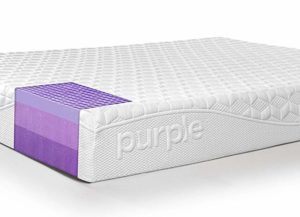 If you’ve browsed any online mattress companies, you’ve surely heard of Purple®. Known for their catchy commercials, Purple® aims to deliver better sleep with their innovative Purple Grid™. featured in every one of their mattress models.
If you’ve browsed any online mattress companies, you’ve surely heard of Purple®. Known for their catchy commercials, Purple® aims to deliver better sleep with their innovative Purple Grid™. featured in every one of their mattress models.
Purple® makes three different mattresses: Original Purple®, Purple® Hybrid, and Purple® Hybrid Premier. The only difference between the Purple® Hybrid and Hybrid Premiere is the thickness of the Purple Grid™. The flagship Purple® mattress differs from both of the hybrid models as it lacks coils.
The Original Purple® mattress has a firm feel that some describe as a medium-firm and others feel is more luxury firm. Ultimately, this mattress is firmer than medium but softer than firm. If you prefer a softer mattress, we recommend choosing one of their hybrid models, as they’re available in different firmness options.
The Purple Grid™ offers “no-pressure” support. It molds to your body to maintain spinal alignment while alleviating pressure. We recommend the Original Purple® to side, back, and stomach sleepers because of the adaptability of the Purple Grid™.
We also recommend the Purple® mattress to hot sleepers since its grid-shaped comfort layer allows for plenty of airflow.
The cover of the Purple® mattress is a stretchy, airy blend of viscose, polyester, and lycra. It further contributes to the conformability and breathability of this bed.
The first layer of the Purple® is 2 inches of Purple Grid™, fashioned out of proprietary hyper-elastic polymer. The hyper-elastic polymer was patented by the founders of Purple®. This material is rubber-like with memory foam-like contouring abilities.
This Purple Grid™ is what gives the bed “no-pressure” support, boosts airflow, and extends the mattress’s longevity. The Purple Grid™ also isolates motion well, so if you share the bed with a partner who tosses and turns, you won’t feel their movement on your side of the bed.
Below this bed’s Purple Grid™ is a 3.5-inch layer of responsive poly-foam to buffer between the grid and base layer of the mattress. The third and final layer of the Purple® mattress is 4 inches of high-density poly-foam to support the layers above and prevent wear and tear.
The Purple® mattress comes with a 100-night sleep trial and a 10-year warranty. It’s sold online and in select Mattress Firm locations.
7. Bear Mattress
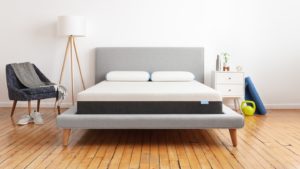 The Bear is another memory foam mattress engineered for athletes. Bear makes and sells three mattress models. Of the three, we like their flagship bed because it contains numerous sleep-promoting technologies. Plus, it costs less than $1,000 for a king-size mattress.
The Bear is another memory foam mattress engineered for athletes. Bear makes and sells three mattress models. Of the three, we like their flagship bed because it contains numerous sleep-promoting technologies. Plus, it costs less than $1,000 for a king-size mattress.
The Bear mattress is best-suited for back and side sleepers but is likely too soft for stomach sleeping. Overall, it has a medium firmness, like many of the other foam beds we’ve featured in this review.
We like the Bear brand because they engineer their mattresses to boost recovery and facilitate deeper sleep. Enhanced sleep begins with the cover of this bed and Bear’s cover includes Celliant® fibers for temperature regulation. Celliant® promotes more restful sleep by recycling your body heat to infrared energy. This process prevents night sweats and promotes local blood flow.
The first layer of the Bear is 2 inches of graphite-infused memory foam. While this layer contours to your body for instant comfort, the graphite infused wicks away heat and moisture. This comfort layer has a slower response to pressure, making it ideal for alleviating pressure under the shoulders and hips.
Next is a 2-inch transition layer of bouncy poly-foam to keep you lifted in the mattress and prevent uncomfortable sinkage. The third and last layer of the Bear mattress is 6 inches of high-density poly-foam to distribute your weight and give the bed structural support.
Bear mattresses are sold online-only. They come with a 100-night sleep trial, a 10-year warranty, and per their return policy, free shipping and free returns, too.
8. Nest Bedding Alexander Signature
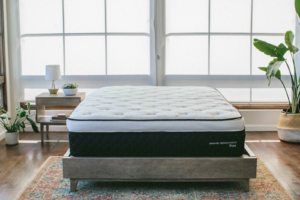 Nest’s Alexander Signature Mattress is designed to be a true medium mattress. The combination of softness and support makes it suitable for side, back, and combination sleepers.
Nest’s Alexander Signature Mattress is designed to be a true medium mattress. The combination of softness and support makes it suitable for side, back, and combination sleepers.
This bed is a hybrid featuring two cooling gel foams and a pocketed coil support base.
The quilted cover of this mattress features a soft thermic phase changing fabric that wicks heat and moisture away from your body as you sleep. This cover can also be easily removed, allowing sleepers to rotate or flip the comfort layers throughout the life of the mattress. Nest recommends doing so every six months to ensure weight is evenly distributed. This feature improves the durability and lifespan of the bed.
The comfort layer of the Alexander Signature is made of 4 inches of gel-infused memory foam to increase temperature control. The gel beads in this layer absorb trapped body heat, so the mattress maintains a neutral temperature.
Beneath the comfort layer is 3 inches of Nest’s TitanChil Endurance Foam®. While contouring to the body for pressure-free support, this foam also helps regulate temperature. To increase responsiveness, Nest includes its SmartFlow Support Foam transition layer. This support foam gives the bed a slight bounce and keeps sleepers lifted on the mattress rather than sunk.
All three foam layers in the Alexander Signature Mattress are backed by a CertiPUR-US® certification. This certification guarantees there will be little to no off-gassing when brought indoors.
Supporting these layers is an 8-inch Quantum Edge Coil Support System. This base features individually wrapped and tuned steel coils. Each coil in this base is zoned to provide the perfect amount of cushioning to prevent pressure points. Nest’s coil base also has reinforced edge support to reduce motion transfer and make getting in and out of bed easier.
Nest’s mattresses can be purchased directly on their website or in one of their showrooms. They include a 100-night comfort guarantee that allows you to test out the bed to be sure it is right for you. They also offer a lifetime warranty to cover any manufacturing defects.
9. Nolah Signature 12
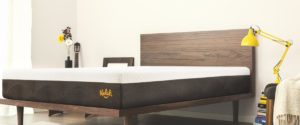 Not all foam mattresses are flippable. The soft, low-density foam used in the top layer of most foam mattresses is not designed to support the bed. Some soft foams will break down and deteriorate without the proper support base. To make their Signature 12” Mattress flippable, they offer different comfort levels on each side of the bed—a soft side and a firm side.
Not all foam mattresses are flippable. The soft, low-density foam used in the top layer of most foam mattresses is not designed to support the bed. Some soft foams will break down and deteriorate without the proper support base. To make their Signature 12” Mattress flippable, they offer different comfort levels on each side of the bed—a soft side and a firm side.
On the soft side, this mattress features 2.5 inches of Nolah’s AirFoam™. This foam contours to the body and keeps air circulating so you stay cool and comfortable. The soft side is suitable for side sleepers and lightweight sleepers in need of more cushioning.
To prevent excessive sinking, a 1.5-inch layer of latex foam lies underneath the soft layer. Latex foam has more elasticity and keeps the body lifted and in alignment.
On the firm side, Nolah includes a 1-inch layer of AirFoam™ with a firmer feel more suited to back and stomach sleepers. This comfort level keeps the hips lifted, so the spine stays neutral.
In the middle of these layers is a 7-inch high-density support foam. This foam supports both sides of the mattress, no matter which firmness you choose. This foam is also breathable so air can flow freely through this base—resulting in less heat retention.
Wrapping all of these layers is a Tencel™ cover made with organic unbleached cotton that is free of harmful pesticides. Tencel™ is also naturally sustainable—making it safer for you and the planet. The quilted pattern on this cover promotes airflow and temperature control.
All four layers of the Nolah Signature are certified by CertiPUR-US® to be low in VOCs and harmful ozone-depleting substances. This certification ensures the mattress will have very little odor once it’s brought home.
The Nolah Signature 12” Mattress can be used on most popular bed frames, including slatted, solid, and adjustable bases. When placing on a slatted foundation, be sure slats are no more than 4 inches apart to prevent sagging.
With each of their mattresses, Nolah offers a 120-night risk-free trial period. This trial allows you adequate time to sleep on the bed in the comfort of your own home. They also provide a lifetime warranty to cover any manufacturing defects.
10. PlushBeds Botanical Bliss®
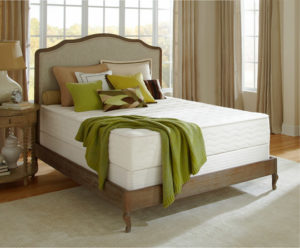 Plushbeds has sourced only organic materials to create their Botanical Bliss® Mattress. This latex foam bed is uniquely customizable—allowing sleepers to choose between 9, 10, or 12 inches of plush latex foam. If you are looking for more contouring and pressure relief, we recommend opting for the 12-inch model.
Plushbeds has sourced only organic materials to create their Botanical Bliss® Mattress. This latex foam bed is uniquely customizable—allowing sleepers to choose between 9, 10, or 12 inches of plush latex foam. If you are looking for more contouring and pressure relief, we recommend opting for the 12-inch model.
The Botanical Bliss® also comes with the option to select a medium or a medium-firm comfort level. If you are a side sleeper, the medium mattress will likely be the most comfortable, while back sleepers may prefer the firm option.
No matter which option you prefer, The Botanical Bliss® features GOLS-certified Dunlop Latex foam. This foam keeps you supported and resting comfortably throughout the night. Because it has elasticity, latex foam has a combination of bounce and contouring.
Latex foam is an excellent option for those with allergies or asthma because this material is resistant to mold, mildew, and dust mites. Latex is also natural and produced without the use of pesticides so this bed will have less off-gassing and harmful irritants.
Surrounding the bed is a breathable cover made with GOTS-certified organic cotton. This cover is guaranteed to be free of dangerous chemicals. Plus, it absorbs moisture, so you sleep cool and dry.
Beneath this cover is a layer of GOTS-certified organic New Zealand wool. Wool regulates heat naturally, so it can absorb moisture and release trapped heat. Wool also acts as a natural flame retardant. By using wool for fire protection, Plushbeds can avoid the use of any toxic chemicals in their mattresses.
In addition to GOTS and GOLS certification, Plushbeds has an eco-Institute® certification. This certification guarantees their mattresses are non-hazardous and free of any harmful allergens.
Plushbeds includes a 100-night risk-free sleep trial with the Botanical Bliss® Mattress. To ensure the mattress supports you for many years, they also include a 25-year warranty.
11. Avocado Green Mattress
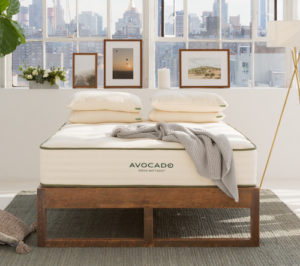 The Avocado Green mattress is the last on our list. Eco-friendly shoppers will like this mattress because it features organic materials. The Avocado Green has also earned numerous third-party safety certifications, meaning it’s safe for sleepers of all ages.
The Avocado Green mattress is the last on our list. Eco-friendly shoppers will like this mattress because it features organic materials. The Avocado Green has also earned numerous third-party safety certifications, meaning it’s safe for sleepers of all ages.
The Avocado Green mattress features organic latex, organic cotton, and organic wool. Both the wool and cotton are GOTS-certified while the latex is GOLS-certified. Below this bed’s quilted cover and foam layer lies an innerspring system. Avocado Green makes their coils with recycled steel. Each coil is tuned to give the bed bounce and offer zoned support. This mattress is GREENGUARD GOLD certified, meaning it’s low in emissions and will never have a “new mattress smell.”
The Avocado Green mattress is described as feeling medium-firm to firm, and it’s recommended for side, back, and stomach sleepers alike. We’re fans of this brand because they offer a 365-night sleep trial. They also include a 25-year warranty to help you get the most for your money.
The Avocado Green contains a cover of organic cotton and wool, it feels soft to the touch and wicks away moisture to keep your temperature neutral. You can buy the Avocado Green with an optional pillow top, too, that features a thin layer of latex within.
Below the cover of the mattress is a layer of latex to contour to your body while keeping you lifted in the bed. Latex is naturally cooling, so it works in tandem with the cotton and wool to keep you at a comfortable temperature.
Next, is a layer of pocketed coils to offer zoned support and improve the bed’s responsiveness. These coils are arranged in five strategic zones to ease pressure under the shoulders and hips.
The Avocado Green lacks a transition layer between the comfort layer of foam and the coil system. So, we expect this mattress to feel notably bouncy and firm.
How to Find the Right Mattress for You?
While reading mattress reviews is helpful when searching for a new mattress, you also have to consider your sleep style and varying mattress types, too. In the next sections, we discuss the importance of a high-quality mattress and how to choose the right mattress to meet your needs.
Importance of a High-Quality Mattress
A healthy body and mind need three components:
- An active lifestyle
- A healthy diet
- A good night’s sleep every night.
While the first two components seem to be taken very seriously, the third one often gets forgotten. A recent study has shown that only 10% of people focus on sleep more than other aspects of daily living. Although the other 90% seem to know that bad sleep habits can have consequences, they still fail to realize how much of a negative effect they can have.
Sleep deprivation is a real concern. According to the National Heart, Lung, and Blood Institute, not getting quality sleep can lead to serious long-term consequences. Your overall mental health, including your decision-making skills, problem-solving skills, and overall emotional stability is impacted. As is your physical state. A lack of sleep can result in an increased risk of heart disease, kidney disease, and high blood pressure.
Keep in mind that sleep is the time for your body to heal itself, restore its chemical balance, and reboot your brain. Missing out on this important period of rest has negative consequences, so it’s important to make sleep a priority.
A scientific study on the effects a mattress has on sleep shows how vital it is to have a good mattress. The results of the study show most people agreed that a new quality mattress had “improved their sleep by 55%.” They also say that “a significant increase in sleep quality and pain reduction was paralleled by a significant decrease in stress.” A connection between sleep and health is scientifically proven.
A good mattress isn’t just for comfort, it’s a vital accessory for good mental and physical health.
Different Types of Mattresses
There are a variety of mattress types you can purchase, and it can be really confusing. So how do you choose the right one out of a seemingly endless number of variations?
There are eight common types of mattresses available on the market. Each type focuses on specific pain points and has different pros and cons.
Memory Foam Mattresses
Rising in popularity due to bed in a box mattress brands and the availability of adjustable beds, memory foam mattresses are comfortable for the majority of sleepers and some of the best beds for pain relief. Memory foam is known for its superior contouring and pressure-relieving abilities. When you lay on one of these mattresses, it molds to your body to offer immediate cushioning comfort, and it adapts with your every movement.
Unlike traditional innerspring mattresses (which were the most popular up until memory foam made its mattress-industry debut), memory foam mattresses respond to individual sleepers and isolate motion—making them excellent mattresses for couples.
Memory foam mattresses are described as “cradling,” with reviews of these beds mention them feeling like a “big hug.” If you are looking for a softer or more cloud-like mattress, you can’t go wrong with memory foam.
Gel Memory Foam Mattresses
The gel mattress is a relatively new creation. Only invented in 2006, it took the mattress industry by surprise. Nothing quite similar was around yet, which is what helped gel mattresses secure their spot on the market.
Gel mattresses are made from gel-infused memory foam. The synthetic gel gets absorbed by the memory foam, which then creates a more breathable material. But the exact ingredients remain a mystery. Manufacturers rarely give away their secrets.
Gel mattresses are cooler to sleep on. They also spring back quicker than ordinary memory foam. Other than that, they’re generally well-reviewed and cost a reasonable price.
Innerspring Mattresses
Innerspring mattresses ruled the industry for many years. Their cost-efficient manufacturing process and materials ensured their popularity on the market. Then, new materials came along and started competing for the crown. Innerspring manufacturers knew they had to adjust in order to survive. Otherwise, they would be pushed out of the market. That’s why there are now four different types of coils found in innerspring mattresses.
- Bonnell coil: The Bonnell coil is the most commonly used coil today. As the very first type of coil invented, Bonnell hasn’t changed that much over the years. Its shape still resembles an hourglass with a knotted top. This design is simple and inexpensive to manufacture.
- Continuous coil: Continuous coil mattresses are made from just one continuous wire. The wire is bent into lots of S shapes and designed to go from the top to the bottom of the mattress. These shapes are then connected by one thick wire-frame. This is what provides a continuous coil mattress its shape and durability.
- Offset coil: In the slightly higher price range, offset coils provide durability, support, and silence. They have a similar design to Bonnell coils, except for having flat sides at the top and the bottom. Offset coils give more support and contour the body better than the Bonnell or continuous coils.
- Pocketed coil (Marshall coil): Standing individual and proud, pocketed coils are not joined by any wire or frame. Instead, they are encased in fabric one by one, with a small connection to each other at the top. This allows the coils to move independently, which is how they provide more support and better motion isolation.
This type of mattress has been around for a pretty long time. And its demand has not shrunk because of its affordability and reasonable comfort. The biggest cons associated with innerspring mattresses are motion transfer and poor conformability; however, if you need the basics from a bed, an innerspring can fit the bill.
Pillow Top Mattresses
Pillow top mattresses are innerspring mattresses with a thick, cushioning topper—hence the name “pillow top.” Pillow tops are usually at least two inches thick, although they can be thicker in some designs.
Pillow tops can be made from several different materials, such as cotton, latex, or memory foam. They provide a luxurious experience, making you feel like you’re sleeping on a cloud.
However, this luxury is priced accordingly, placing pillow top mattresses in the high price range.
Latex Mattresses
There are three types of latex that can be used to manufacture a latex mattress. First is natural latex, which is made from the sap of a rubber tree. Natural latex can be manufactured in one of two ways: the Dunlop process or Talalay process.
- The Dunlop method involves pouring the latex into the mold in one go. This creates a mattress layer that feels denser at the bottom and slightly softer on the top.
- The Talalay method is a bit more complicated. It includes pouring the latex into the mold, removing any air from the mold, and then freezing it. This creates a more consistent latex foam mattress.
Dunlop latex is heavy and dense, whereas Talalay latex is soft and bouncy. Dunlop tends to have a firmer feel than Talalay latex, so you’ll commonly find Dunlop latex in the supportive layers of a mattress or in the comfort layer of a firm latex bed.
Second is synthetic latex. This is a much cheaper alternative to natural latex. However, cheaper also means poorer quality. Made from petroleum by-products, synthetic latex tends to wear out faster.
The third kind is blended latex. This type includes both natural and synthetic latex. It’s not as long-lasting as natural latex, but it holds fewer chemicals than synthetic latex. All in all, this makes it a compromise product between synthetic and natural latex.
Hybrid Mattresses
Hybrid mattresses combine foam layers and innerspring coils to offer both cushioning comfort and bouncy responsiveness. Many beds are labeled as “hybrids” because they contain a mix of materials, but a true hybrid mattress has at least 2 inches of foam atop a layer of coils.
Hybrids can feature memory foam, latex foam, or poly-foam, in addition to pocketed coils. These beds were designed to offer the benefits of both foam and innersprings while minimizing their drawbacks. For example, innerspring mattresses are cooling but they tend to transfer motion, whereas hybrid mattresses harness the cooling properties of innersprings and because they have foam layers, they also isolate motion quite well.
The foam layers in these beds provide the pressure relief and motion isolation, while their innersprings offer breathability and bounciness; this makes hybrid mattresses great for hot sleepers and couples. Ultimately, we recommend hybrids to anybody who prefers the bounciness of an innerspring mattress but still wants or needs the cushioning of foam layers.
Waterbeds
Known for their therapeutic properties, waterbeds have been around longer than innerspring mattresses. And with the consistent development of new designs, it looks like they’ll stay around for a while—despite their loss in popularity.
Today, there are two main types of waterbeds available.
- Soft-side Waterbed: This type of waterbed has sturdy sides and a supportive top that don’t require any extra support. It can be used by itself or be incorporated into existing bedroom furniture.
- Hard-side Waterbed: A hard-side waterbed is made from a water-filled mattress and a wooden frame. Both come as an inseparable duo, providing each other with the needed support. Although bulkier, and not as chic as a soft-side, hard-side waterbeds are a lot more affordable, making it more attainable.
Airbeds
Airbeds inflate with air using automated pumps or a bit of manual labor. They’re an excellent choice for comfortable camping, or as an extra sleeping arrangement for your guests. With a huge variety in height and sizing, airbeds are great to have around the house for unexpected surprises.
When deflated, airbeds take a minimal amount of space and can be packed away with ease. When inflated using an air pump, a double airbed can hold up to 450 lbs. Although an airbed should not be used as a permanent bed you sleep on, it is great to have for emergencies.
Mattress Sizes
While shopping for a new bed you will also want to consider mattress size. If you and your spouse are starting to feel cramped on your current queen mattress, it may be time to upgrade to a king. Or, maybe you are a solo sleeper looking for more legroom. Either way, it is helpful to understand the difference in each mattress size before buying a new bed. To help you compare dimensions, we have provided a quick overview of each size below.
Mattress Size Comparison Chart
| Size | Width | Length |
| Twin | 38 inches | 75 inches |
| Twin XL | 38 inches | 80 inches |
| Full | 54 inches | 75 inches |
| Full XL | 54 inches | 80 inches |
| Queen | 60 inches | 80 inches |
| Olympic Queen | 66 inches | 80 inches |
| King | 76 inches | 80 inches |
| California King | 75 inches | 84 inches |
Twin vs. Twin XL
38 inches by 75 inches and 38 inches by 80 inches
For children we have outgrown their cribs, twin mattresses are a perfect fit. To accommodate them as they grow, a twin XL offers a little more length. Twin XLs are 5 inches longer than standard twin mattresses, so you don’t have to worry about feet dangling off the edge of the bed.
Young adults who need a twin mattress for a dorm room or a small apartment will also benefit from the extra legroom that comes with a twin XL.
Full vs. Full XL
54 inches by 75 inches and 54 inches by 80 inches
Full mattresses, (also called “double mattresses”), are perfect for growing teens and adult solo sleepers. Single sleepers will be able to spread out comfortably in a full-size bed without feeling confined. Like a twin XL, full XLs have 5 more inches of length and offer more clearance of taller individuals.
In a standard U.S. bedroom (11 by 12 feet), full beds fit comfortably and still allow plenty of room to move around the bed.
Queen
60 inches by 80 inches
Queen mattresses are a great choice for couples, but they also create a luxurious sleep experience for solo sleepers. In fact, queens are by far the most popular choice in the U.S. These mattresses fit well into most standard size bedrooms without taking up the entire room.
King (Eastern King)
76 inches by 80 inches
Over time, many couples start to find queen mattresses confining. If you have children who like to crawl into bed with you, you may find yourself pushed to the edge of the mattress when resting on a queen. Or, your spouse may be a restless sleeper, and you each require more space. When this happens, it may be time to upgrade to a king-size mattress. These mattresses provide ample room for both people to spread out and get comfortable.
Since queens take up more surface space, you will want to measure your bedroom before purchasing a queen size mattress. These beds typically fit comfortably in a master bedroom but may feel cramped in a standard 11 by 12-foot bedroom.
California King (Western King)
72 inches by 84 inches
Many people are under the impression that California king size mattresses are bigger than standard kings. But California kings have less surface area than a king. Standard kings have 6080 square inches, while California kings have 6048 square inches.
The primary difference between king and California king-size beds is the extra length. California kings are 4 inches longer than a standard king—making them ideal for individuals taller than 6 feet. But, Cal kings are also 4 inches short in width. Based on your body type and sleep habits, you will have to decide where you want the extra length.
As with standard kings, you will want to measure your bedroom to ensure it can accommodate a California king-size mattress.
Sleeping Positions
Deciding on the firmness of a mattress is usually where people feel lost in their search for a new bed; however, many people don’t know that their preferred sleep style can actually tell you how firm your new mattress should be. Different sleep positions need different levels of support, so reflecting on yours puts you one step closer to making a final purchase.
Don’t forget to factor in your body type, too. A side sleeper who weighs 230 pounds will need more support than a side sleeper weighing less than 130 pounds. We recommend plus-size sleepers choose a mattress slightly firmer than what’s typically recommended, as firmer mattresses offer adequate support to prevent uncomfortable sinkage and facilitate healthy, comfortable sleep.
Side Sleepers
The best mattresses for side sleepers are soft to medium in firmness since firmer beds can cause pressure points under the shoulders and hips. When you sleep on your side, your shoulders and hips take on the majority of your body weight, so it’s important that your mattress is soft enough to allow those joints to sink into the mattress for adequate pressure relief.
Side sleepers don’t want to choose too soft of a mattress though, as ultra-soft beds can cause you to sink too far, resulting in misalignment. Typically, side sleepers need an even balance of comfort and support and are best-suited on medium mattresses.
Back Sleepers
Back sleeping is uncommon, but healthy for the spine. In order to reap the benefits of back sleeping, your mattress must be firm enough to keep you lifted in neutral alignment. Back sleepers can be comfortable on medium-soft to medium-firm beds, and deciding on firmness ultimately comes down to body weight. Petite back sleepers will likely prefer softer beds, while heavier back sleepers will want something firmer to provide necessary support and prevent the hips from dipping.
Stomach Sleepers
Stomach sleeping is unhealthy due to the stress it puts on your spine. When you sleep flat on your stomach, your center of gravity shifts to your midsection, so if your mattress is soft, it’ll allow your midsection to sink, resulting in back pain. We suggest avoiding stomach sleeping altogether to prevent chronic backaches, but if you’re set on sleeping on your stomach, choose a firm mattress to keep your spine in alignment.
Combination Sleepers
Combination sleepers, as their name suggests, sleep in a combination of positions. These sleepers may fall asleep on their back and roll to their side, or start as a side sleeper and wake up sleeping with their belly flat against the mattress. We recommend medium mattresses for combination sleepers since they offer both comfort and support to promote healthy sleep in a variety of sleeping positions.
Other Things to Consider
Sleep Trials
Most reputable bed-in-a-box brands offer a risk-free sleep trial period. This trial provides sleepers a set length of time to try out the mattress in the comfort of their own home. When shopping for a bed in a brick and mortar store, it can be difficult to get an idea of its comfort level. Plus, it can take up to 3 weeks to become accustomed to a new bed. A 5 to 10-minute “test” of a mattress is not enough to find out how it will support you. That’s where a sleep trial can help.
Purchasing a new mattress is a big decision, and most companies want to guarantee you are happy with your purchase. If you are not satisfied with the bed, they will issue you a full refund. When shopping, look for a sleep trial of at least 90-days. This length of time is standard in the mattress industry and helps sleepers ensure that the bed is right for them.
If a mattress doesn’t offer a sleep trial, they may include a return policy. To ensure you have adequate time to try out the bed, look for a return policy that is at least 30-days. Once you bring your new mattress home, be sure to keep track of the days. Some return policies will start the date of purchase, while others will begin once the mattress is delivered.
Warranties
Most mattress manufacturers offer a 10-year warranty to protect against any defects. However, it is essential to remember that warranties do not always suggest the life of the mattress. Most innerspring mattresses last between 6 to 8 years. Memory and latex foam mattresses last around 10 to 12 years.
Warranties longer than ten years are typically prorated. A prorated warranty means the customer will be responsible for a percentage of the repair after the first ten years of use.
Warranties also don’t cover customer misuse, such as spills, or placing the mattress on the incorrect foundation. To protect your investment, a mattress protector will keep your bed clean and in good repair. Also, be sure to read your warranty and ensure that you are placing the bed on the correct surface.
Conclusion
Finding the right mattress for your sleep needs isn’t as tricky as one might think. As long as you keep your sleep style, preference for firmness, and any recurring aches and pains in mind as you shop, you’re bound to find a comfortable bed. Don’t forget to utilize mattress reviews and other resources while shopping, too.
This article is for informational purposes and should not replace advice from your doctor or other medical professional.